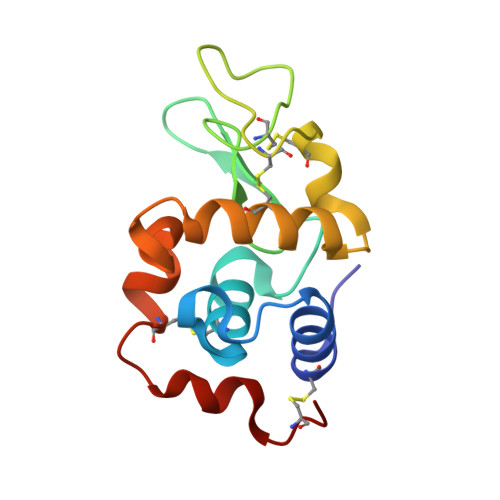Unusual Structural Features in the Adduct of Dirhodium Tetraacetate with Lysozyme.
Loreto, D., Ferraro, G., Merlino, A.(2021) Int J Mol Sci 22
- PubMed: 33540880
- DOI: https://doi.org/10.3390/ijms22031496
- Primary Citation of Related Structures:
7BDZ, 7BE0, 7BE1, 7BE2, 7BEB, 7BEC - PubMed Abstract:
The structures of the adducts formed upon reaction of the cytotoxic paddlewheel dirhodium complex [Rh 2 (μ-O 2 CCH 3 ) 4 ] with the model protein hen egg white lysozyme (HEWL) under different experimental conditions are reported. Results indicate that [Rh 2 (μ-O 2 CCH 3 ) 4 ] extensively reacts with HEWL:it in part breaks down, at variance with what happens in reactions with other proteins. A Rh center coordinates the side chains of Arg14 and His15. Dimeric Rh-Rh units with Rh-Rh distances between 2.3 and 2.5 Å are bound to the side chains of Asp18, Asp101, Asn93, and Lys96, while a dirhodium unit with a Rh-Rh distance of 3.2-3.4 Å binds the C-terminal carboxylate and the side chain of Lys13 at the interface between two symmetry-related molecules. An additional monometallic fragment binds the side chain of Lys33. These data, which are supported by replicated structural determinations, shed light on the reactivity of dirhodium tetracarboxylates with proteins, providing useful information for the design of new Rh-containing biomaterials with an array of potential applications in the field of catalysis or of medicinal chemistry and valuable insight into the mechanism of action of these potential anticancer agents.
Organizational Affiliation:
Department of Chemical Sciences, University of Naples Federico II, 80126 Napoli, Italy.



















